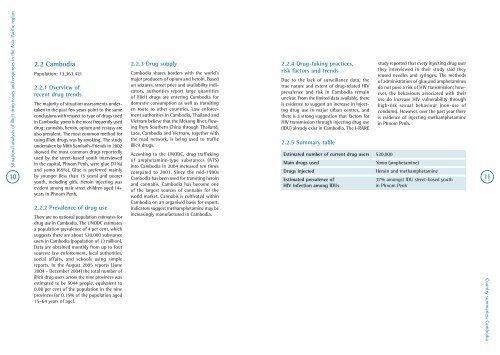Illicit Drug use in the Asia Pacific Region - Burnet Institute
Illicit Drug use in the Asia Pacific Region - Burnet Institute
Illicit Drug use in the Asia Pacific Region - Burnet Institute
Create successful ePaper yourself
Turn your PDF publications into a flip-book with our unique Google optimized e-Paper software.
Situational analysis of illicit drug issues and responses <strong>in</strong> <strong>the</strong> <strong>Asia</strong>–<strong>Pacific</strong> region<br />
10<br />
2 .2 Cambodia<br />
Population: 13,363,421<br />
2 .2 .1 Overview of<br />
recent drug trends<br />
The majority of situation assessments undertaken<br />
<strong>in</strong> <strong>the</strong> past few years po<strong>in</strong>t to <strong>the</strong> same<br />
conclusions with respect to type of drugs <strong>use</strong>d<br />
<strong>in</strong> Cambodia: yama is <strong>the</strong> most frequently <strong>use</strong>d<br />
drug; cannabis, hero<strong>in</strong>, opium and ecstasy are<br />
also prevalent . The most common method for<br />
us<strong>in</strong>g illicit drugs was by smok<strong>in</strong>g . The study<br />
undertaken by Mith Samlanh–Friends <strong>in</strong> 2002<br />
showed <strong>the</strong> most common drugs reportedly<br />
<strong>use</strong>d by <strong>the</strong> street-based youth <strong>in</strong>terviewed<br />
<strong>in</strong> <strong>the</strong> capital, Phnom Penh, were glue (71%)<br />
and yama (65%) . Glue is preferred ma<strong>in</strong>ly<br />
by younger (less than 15 years) and poorer<br />
youth, <strong>in</strong>clud<strong>in</strong>g girls . Hero<strong>in</strong> <strong>in</strong>ject<strong>in</strong>g was<br />
evident among male street children aged 14+<br />
years <strong>in</strong> Phnom Penh .<br />
2 .2 .2 Prevalence of drug <strong>use</strong><br />
There are no national population estimates for<br />
drug <strong>use</strong> <strong>in</strong> Cambodia . The UNODC estimates<br />
a population prevalence of 4 per cent, which<br />
suggests <strong>the</strong>re are about 520,000 substance<br />
<strong>use</strong>rs <strong>in</strong> Cambodia (population of 13 million) .<br />
Data are obta<strong>in</strong>ed monthly from up to four<br />
sources: law enforcement, local authorities,<br />
social affairs, and schools us<strong>in</strong>g simple<br />
reports . In <strong>the</strong> August 2005 reports (June<br />
2004 – December 2004) <strong>the</strong> total number of<br />
illicit drug <strong>use</strong>rs across <strong>the</strong> n<strong>in</strong>e prov<strong>in</strong>ces was<br />
estimated to be 5044 people, equivalent to<br />
0 .08 per cent of <strong>the</strong> population <strong>in</strong> <strong>the</strong> n<strong>in</strong>e<br />
prov<strong>in</strong>ces (or 0 .15% of <strong>the</strong> population aged<br />
15–64 years of age) .<br />
2 .2 .3 <strong>Drug</strong> supply<br />
Cambodia shares borders with <strong>the</strong> world’s<br />
major producers of opium and hero<strong>in</strong> . Based<br />
on seizures, street price and availability <strong>in</strong>dicators,<br />
authorities report large quantities<br />
of illicit drugs are enter<strong>in</strong>g Cambodia for<br />
domestic consumption as well as transit<strong>in</strong>g<br />
en route to o<strong>the</strong>r countries . Law enforcement<br />
authorities <strong>in</strong> Cambodia, Thailand and<br />
Vietnam believe that <strong>the</strong> Mekong River, flow<strong>in</strong>g<br />
from Sou<strong>the</strong>rn Ch<strong>in</strong>a through Thailand,<br />
Laos, Cambodia and Vietnam, toge<strong>the</strong>r with<br />
<strong>the</strong> road network, is be<strong>in</strong>g <strong>use</strong>d to traffic<br />
illicit drugs .<br />
Accord<strong>in</strong>g to <strong>the</strong> UNODC, drug traffick<strong>in</strong>g<br />
of amphetam<strong>in</strong>e-type substances (ATS)<br />
<strong>in</strong>to Cambodia <strong>in</strong> 2004 <strong>in</strong>creased ten times<br />
compared to 2003 . S<strong>in</strong>ce <strong>the</strong> mid-1990s<br />
Cambodia has been <strong>use</strong>d for transit<strong>in</strong>g hero<strong>in</strong><br />
and cannabis . Cambodia has become one<br />
of <strong>the</strong> largest sources of cannabis for <strong>the</strong><br />
world market . Cannabis is cultivated with<strong>in</strong><br />
Cambodia on an organised basis for export .<br />
Indicators suggest methamphetam<strong>in</strong>e may be<br />
<strong>in</strong>creas<strong>in</strong>gly manufactured <strong>in</strong> Cambodia .<br />
2 .2 .4 <strong>Drug</strong>-tak<strong>in</strong>g practices,<br />
risk factors and trends<br />
Due to <strong>the</strong> lack of surveillance data, <strong>the</strong><br />
true nature and extent of drug-related HIV<br />
prevalence and risk <strong>in</strong> Cambodia rema<strong>in</strong><br />
unclear . From <strong>the</strong> limited data available, <strong>the</strong>re<br />
is evidence to suggest an <strong>in</strong>crease <strong>in</strong> <strong>in</strong>ject<strong>in</strong>g<br />
drug <strong>use</strong> <strong>in</strong> major urban centres, and<br />
<strong>the</strong>re is a strong suggestion that factors for<br />
HIV transmission through <strong>in</strong>ject<strong>in</strong>g drug <strong>use</strong><br />
(IDU) already exist <strong>in</strong> Cambodia . The I-RARE<br />
2 .2 .5 Summary table<br />
Estimated number of current drug <strong>use</strong>rs 520,000<br />
Ma<strong>in</strong> drugs <strong>use</strong>d Yama (amphetam<strong>in</strong>e)<br />
study reported that every <strong>in</strong>ject<strong>in</strong>g drug <strong>use</strong>r<br />
<strong>the</strong>y <strong>in</strong>terviewed <strong>in</strong> <strong>the</strong>ir study said <strong>the</strong>y<br />
re<strong>use</strong>d needles and syr<strong>in</strong>ges . The methods<br />
of adm<strong>in</strong>istration of glue and amphetam<strong>in</strong>es<br />
do not pose a risk of HIV transmission; however,<br />
<strong>the</strong> behaviours associated with <strong>the</strong>ir<br />
<strong>use</strong> do <strong>in</strong>crease HIV vulnerability through<br />
high-risk sexual behaviour (non-<strong>use</strong> of<br />
condoms) . However, over <strong>the</strong> past year <strong>the</strong>re<br />
is evidence of <strong>in</strong>ject<strong>in</strong>g methamphetam<strong>in</strong>e<br />
<strong>in</strong> Phnom Penh .<br />
<strong>Drug</strong>s <strong>in</strong>jected Hero<strong>in</strong> and methamphetam<strong>in</strong>e<br />
Estimated prevalence of<br />
HIV <strong>in</strong>fection among IDUs<br />
37% amongst IDU street-based youth<br />
<strong>in</strong> Phnom Penh<br />
11<br />
Country summaries: Cambodia









